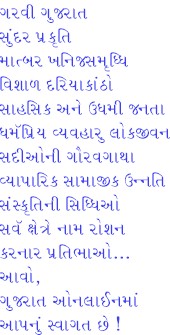

| Introduction |
 |
Welcome,
|
Information Gujarat, is one of India's most industrialized states, in western India, covering an area of 196,024 sq km (75,685 sq mi). It has a fertile plain land in the south cut by several rivers, low hills in the west, and broad mudflats in the north that adjoin the Thar (Great Indian) Desert. Geographical: The climate of Gujarat is varied. The northwestern part of the state is dry, with less than 500 mm (20 in) of rain a year. In the more temperate central part of the state, the annual rainfall is more than 700 mm (28 in). In the southern part of Gujarat, rainfall averages 2000 mm (79 in) a year. In the winter temperatures average between 12° and 27° C (between 54° and 81° F), although freezing levels have been recorded in the state. In the summer temperatures average between 25° and 43° C (77° and 109° F) and have been known to reach as high as 48° C (118° F). People: The population was 41,309,582 at the 1991 census, giving it an average density of 211 persons per sq km (546 per sq mi). More than 70 percent of the population is Hindu; there are also significant minorities of Muslims and Jains in Gujarat In 1991 more than 60 percent of the population was literate. Education: Gujarat has two official languages: Gujarati, which is derived from Sanskrit, and Hindi. Several universities are located in Gujarat including Bhavnagar University (founded in 1978) in Bhavnagar, Gujarat University (1950) in Ahmedabad, Sardar Patel University (1955) in Kheda, and Saurashtra University (1967) in Rajkot. Agriculture: The leading crops are rice, maize (corn), peanuts, cotton, and tobacco. Among livestock raised are buffalo and other cattle, sheep, and goats. Salt, manganese, limestone, and bauxite are mined. Petroleum production began in 1960, and an oil refinery is located at Vadodra. Industries: One of India's most industrialized states, Gujarat maintains a variety of industries, the principal ones being general and electrical engineering and the manufacture of textiles, vegetable oils, chemicals, soda ash, and cement. New industries include the production of fertilizers and petrochemicals. Political: The state capital is Gandhinagar. The state has a single-chamber legislative assembly with 182 members. The state sends 37 members to the Indian national parliament: 11 to the Rajya Sabha (Upper House) and 26 to the Lok Sabha (Lower House). Local government is based on 19 administrative districts. History: Signs of civilization in the region that is now Gujarat date back to the period from 3000 to 1500 BC. The region was part of the Mauryan Empire in the 3rd century BC under King Asoka. In 1818 the British East India Company took control of Gujarat administering the state through local princely rulers. With the independence of India in 1947, Gujarat became part of the state of Bombay. In 1960 Bombay state was split up, and Gujarat was formed from the northern and western portions, which were predominantly Gujarati-speaking areas. The remainder of Bombay state became Maharashtra state. Cities having population over 100000
|
We hope you enjoy this section. |